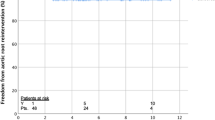Abstract
Objectives
This study aimed to compare short- and long-term results for patients undergoing either aortic valve-sparing reimplantation (David) procedure (AVr-D) or biological aortic root replacement (Bentall) procedure (ARr-B-bio) for aortic root pathology.
Methods
We compared outcomes for patients who underwent AVr-D (n = 261) or ARr-B-bio (n = 150) between 2000 and 2015 at our institution. The mean age of patients was 55 ± 13 years and 21.7% (n = 89) were female. ARr-B-bio patients were significantly older than AVr-D patients (58 ± 10 vs 53 ± 15 years, p < 0.001) and had a significantly lower incidence of connective tissue disorders (2.0% vs 16.9%, p < 0.001). Follow-up was complete in 88% of patients.
Results
Mortality at 30 days was 1.2% (n = 5) overall, at 0.4% (n = 1) significantly lower in the AVr-D group compared with 2.7% (n = 4) in the ARr-B-bio group (p = 0.04). Postoperative low cardiac output was more common in ARr-B-bio patients (n = 4) versus AVr-D patients (n = 0; p = 0.008). The occurrence of postoperative strokes was 2.2% (n = 9) in both groups, without significant differences (p = 0.84). Five- and ten-year survival was 93.7 ± 1.8% and 84.4 ± 4.7% in patients who received AVr-D and 90.9 ± 2.6% and 84.6 ± 5.4% for ARr-B-bio patients (log-rank p = 0.37). Using Cox regression analysis, age (HR 1.06; 95% CI 1.02–1.10, p = 0.002), smoking (HR 2.74; 95% CI 1.28–5.86, p = 0.01), and emergency surgery (HR 6.58; 95% CI 1.69–25.54, p = 0.007) were found to be independent predictors of long-term mortality.
There was no difference in freedom from reoperation between AVr-D (89.4 ± 3.4% at 10 years) and ARr-B-bio (80.4 ± 7.5% at 10 years, log-rank p = 0.66) patients, nor for freedom from stroke, bleeding, myocardial infarction, or endocarditis during follow-up.
Conclusions
Short-term outcomes for both AVr-D and ARr-B-bio are excellent in patients with aortic root pathology. The long-term outcomes were associated with comparable survival and freedom from reoperation. AVr-D may be preferable to ARr-B-bio in patients with suitable pathoanatomy.


Similar content being viewed by others
References
Ouzounian M, Rao V, Manlhiot C, et al. Valve-sparing root replacement compared with composite valve graft procedures in patients with aortic root dilation. J Am Coll Cardiol. 2016;68:1838–47.
De Paulis R, Scaffa R, Salica A, Weltert L, Chirichilli I. Biological solutions to aortic root replacement: valve-sparing versus bioprosthetic conduit. J Vis Surg. 2018;4:94.
Gaudino M, Di Franco A, Ohmes LB, et al. Biological solutions to aortic root replacement: valve-sparing versus bioprosthetic conduit. Interact Cardiovasc Thorac Surg. 2017;24:855–61.
Bentall H, De Bono A. A technique for complete replacement of the ascending aorta. Thorax. 1968;23:338–9.
Leontyev S, Trommer C, Subramanian S, et al. The outcome after valve-sparing (David) operation in 179 patients: a single-Centre experience. Eur J Cardiothorac Surg. 2012;42:261–6.
Leontyev S, Misfeld M, Daviewala P, et al. Early- and medium-term results after aortic arch replacement with frozen elephant trunk techniques—a single center study. Ann Cardiothorac Surg. 2013;2:606–11.
Borger MA, Fedak PWM, Stephens EH, et al. The American Association for Thoracic Surgery consensus guidelines on bicuspid aortic valve–related aortopathy: executive summary. J Thorac Cardiovasc Surg. 2018;156:473–80.
Arabkhani B, Mookhoek A, Di Centa I, et al. Reported outcome after valve-sparing aortic root replacement for aortic root aneurysm: a systematic review and meta-analysis. Ann Thorac Surg. 2015;100:1126–31.
Gaudino M, Lau C, Munjal M, Avgerinos D, Girardi LN. Contemporary outcomes of surgery for aortic root aneurysms: a propensity-matched comparison of valve-sparing and composite valve graft replacement. J Thorac Cardiovasc Surg. 2015;150:1120–9.
Svensson LG, Pillai ST, Rajeswaran J, et al. Long-term survival, valve durability, and reoperation for 4 aortic root procedures combined with ascending aorta replacement. J Thorac Cardiovasc Surg. 2016;151:764–74.
Stamou SC, Williams ML, Gunn TM, Hagberg RC, Lobdell KW, Kouchoukos NT. Aortic root surgery in the United States: a report from the Society of Thoracic Surgeons database. J Thorac Cardiovasc Surg. 2015;149:116–22.
Subramanian S, Leontyev S, Borger MA, Trommer C, Misfeld M, Mohr FW. Valve-sparing root reconstruction does not compromise survival in acute type a aortic dissection. Ann Thorac Surg. 2012;94:1230–4.
Kunihara T. Toward standardization of valve-sparing root replacement and annuloplasty. Gen Thorac Cardiovasc Surg. 2018;66:685–91.
Kari FA, Doll KN, Hemmer W, et al. Residual and progressive aortic regurgitation after valve-sparing root replacement: a propensity-matched multi-institutional analysis in 764 patients. Ann Thorac Surg. 2016;101:1500–6.
Johnston DR, Soltesz EG, Vakil N, et al. Long-term durability of bioprosthetic aortic valves: implications from 12,569 implants. Ann Thorac Surg. 2015;99:1239–47.
Bourguignon T, Lhommet P, El Khoury R, et al. Very long-term outcomes of the Carpentier-Edwards Perimount aortic valve in patients aged 50–65 years. Eur J Cardiothorac Surg. 2016;49:1462–8.
Funding
No funding
Author information
Authors and Affiliations
Corresponding author
Ethics declarations
The local ethics committee approved the study and waived individual patient consent for retrospective review. This article does not contain any studies with animals performed by any of the authors.
Conflict of interest
Lukas Schamberger declares that he has no conflict of interest.
Sergey Leontyev receives proctoring honoraria fees from Medtronic, Abott (St. Jude Medical).
Piroze M. Davierwala declares that he has no conflict of interest.
Konstantin Von Aspern declares that he has no conflict of interest.
Sven Lehmann receives honoraria fees from Abott (St. Jude Medical).
Martin Misfeld declares that he has no conflict of interest.
Michael Borger receives speakers’ honoraria/consulting fees from Edwards Lifesciences, Medtronic, Abott (St. Jude Medical), and CryoLife.
Additional information
Publisher’s note
Springer Nature remains neutral with regard to jurisdictional claims in published maps and institutional affiliations.
Rights and permissions
About this article
Cite this article
Schamberger, L., Leontyev, S., Davierwala, P.M. et al. David aortic valve-sparing reimplantation versus biological aortic root replacement: a retrospective analysis of 411 patients. Indian J Thorac Cardiovasc Surg 36 (Suppl 1), 97–103 (2020). https://doi.org/10.1007/s12055-019-00873-4
Received:
Revised:
Accepted:
Published:
Issue Date:
DOI: https://doi.org/10.1007/s12055-019-00873-4




